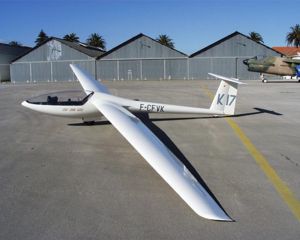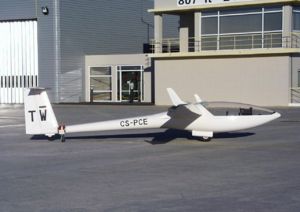PlaneSpottingWorld welcomes all new members! Please gives your ideas at the Terminal.
Glaser-Dirks DG-300
| A DG-300WL at Évora, Portugal. | |
| Type designation | DG-300 |
| Competition class | Club (formerly Standard) |
| Number built | 511 |
| Crew | 1 |
| Length | 6.80 m (22.36 ft) |
| Height | 1.39 m (4.56 ft) |
| Cockpit width | 0.63 m (2.07 ft) |
| Cockpit height | 0.81 m (2.66 ft) |
| Wingspan | 15 m (49.2 ft) |
| Wing area | 10.27 m² (110.5 ft²) |
| Aspect ratio | 21.8 |
| Wing profile | Horst & Quast HQ21/II |
| Empty mass | ca. 245 kg (540 lb) |
| Water ballast | 190 kg (419 lb) or 130 kg (286 lb) |
| Tail water ballast | 5.5 kg (12 lb) optional |
| Maximum mass | 525 kg (1157 lb) |
| Wing loading | ca. 32 – 51 kg/m² (6.6 – 10.5 lb/ft²) |
| Maximum speed | 270 km/h (146 knots) |
| Speed in rough air | 200 km/h (108 knots) |
| Stall speed | 65 km/h (35 mph) at 32 kg/m² |
| Minimum sink rate | ca. 0.59 m/s at 78 km/h (116 ft/min at 42 knots) |
| Best glide ratio | ca. 41 at 100 km/h (54 knots) 42 for DG-300WL |
| Roll rate (-45 to +45 bank) |
4 s at 95 km/h (50 knots) |

The DG-300 is a Standard Class single-seat high performance sailplane built of glass reinforced plastic. The DG-300 was designed by Wilhelm Dirks and manufactured by Glaser-Dirks Flugzeugbau and later by the Slovenian company Elan. A total of 511 of all versions were built since production started in 1983. Representative contemporary types from competing manufacturers are the Rolladen-Schneider LS4 and the Schempp-Hirth Discus.
General description
The DG-300 has a flapless wing with triple taper based on the Falcon designed by Hansjörg Streifeneder, and employs the HQ 21/II, a relatively thick profile (ca. 17.5%). This wing is 'blown' on the underside by 900 small holes to achieve a controlled transition from laminar to turbulent flow. As with any racing sailplane, the thickness of the wing makes it relatively sensitive to performance degradation due to contamination by insect impacts or rain drops.
It is agile and a good climber, but slightly underperforms compared to its competitors in cruising flight, especially at higher speeds. The later Dg-303 version with a new wing profile and winglets was developed that delivers higher performance at low to medium speeds plus increased aileron response. A fully aerobatic version (the Acro) is also available, stressed for +7/-5g.
The DG-300 has typical DG features, which improve comfort and safety if at a performance cost. It has the large cockpit typical of DG giving excellent comfort, especially in high altitude flight where the full-length canopy allows the feet to be warmed by sunlight. The view from the cockpit is superb, adding to the pleasure and safety of flight.
After the bankcrupcy of Glaser-Dirks the newly founded DG Flugzeugbau GmbH took over the servicing of these gliders.
Major features
- Wings: spar of GRP rovings, wing shell of GRP / foam sandwich
- Elevator: GRP shell
- Rudder: GRP / foam sandwich
- Fuselage: GRP shell
- Conventional T-tail with fixed stabiliser and moving elevator
- Retractable, sprung undercarriage in a sealed gear box
- Large 5"x5" hub main wheel, 200x50mm tail wheel
- Parallelogram control stick
- Automatic control connections
- Self-trimming spring system for the elevator, with trigger release on the control stick
- Schempp-Hirth air brakes on upper wing surface
- Water ballast bags in the wings for 130 or 190 litres
- Very large canopy with low sill giving excellent in-flight visibility
Versions
- The DG-300 Club has a fixed undercarriage for club use.
- The DG-300 Acro is fully aerobatic.
- The DG-303 Elan has winglets and is available in standard, club and acro versions. It was built by the Slovenian company AMS-Flight until end of 2005.

